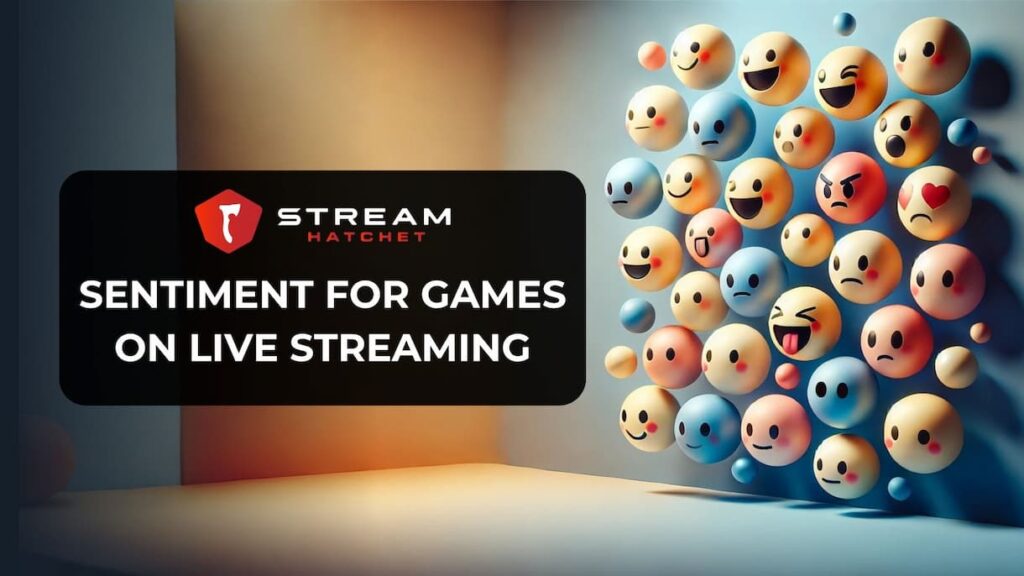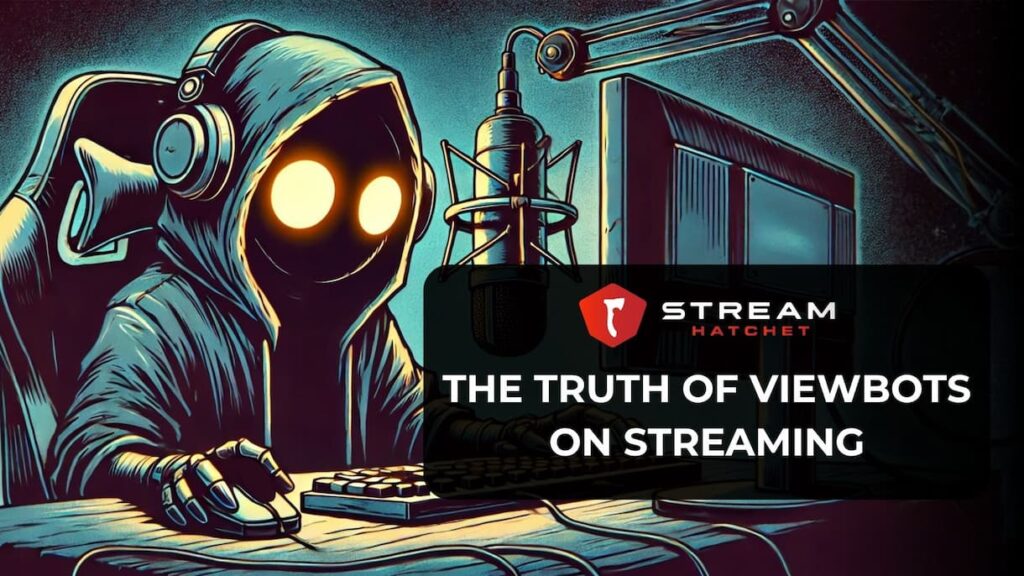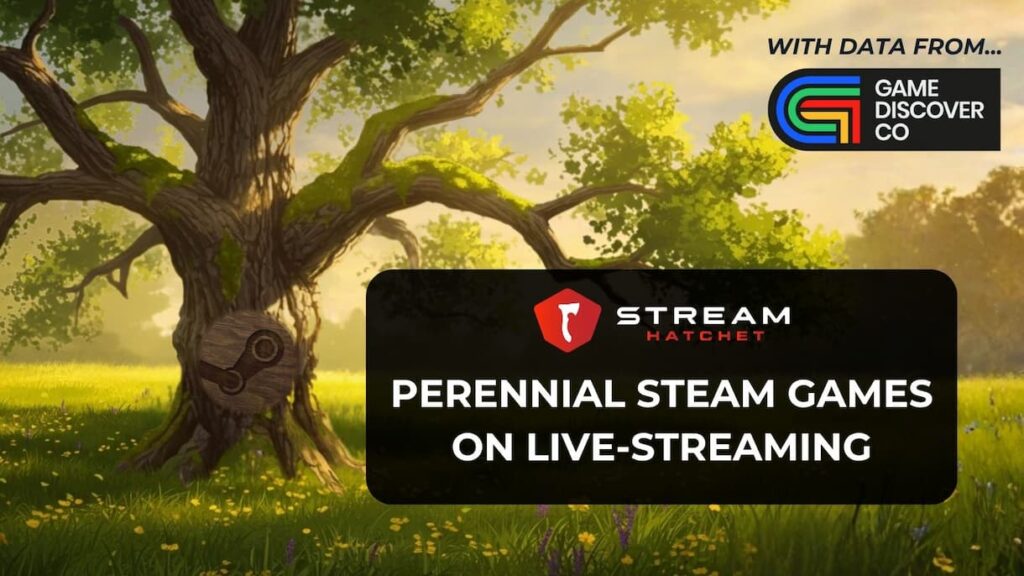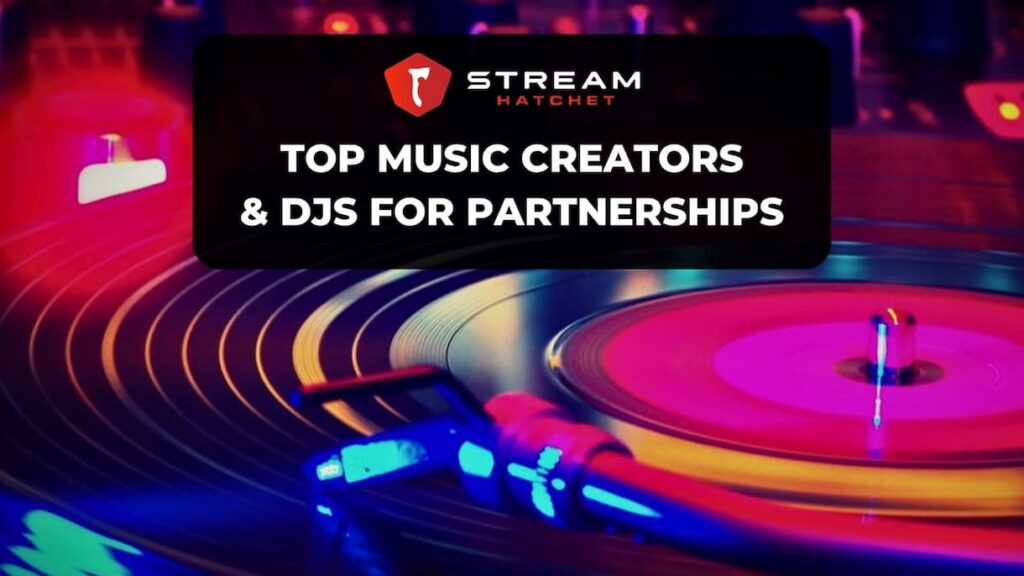Live streaming forms the vanguard of modern marketing strategies, connecting brands with fans through the intimate relationships they develop with content creators. As a burgeoning industry, the state of play is constantly changing: It takes an expert to navigate the ever-shifting meta of new platforms, personalities, and popular video games.
This comprehensive introduction demystifies live streaming, giving a brief glimpse into some of the core concepts and characters underpinning the modern industry. By understanding the way companies discuss live streaming data, you can better leverage one of the newest – and most useful – modern media distribution channels.
Here are 8 Key Topics About the Live-Streaming Industry:
- Definition of Live Streaming
- History of Live Streaming
- The Full Array of Live Streaming Platforms
- The Top Names Among Live Streamers
- The Most Popular Games on Live Streaming
- Marketing on Live Streaming
- Regional Popularity of Live Streaming
- Key Metrics in Live Streaming Analysis
For a personal guide through the live-streaming industry, reach out to one of Stream Hatchet’s consultants:
The Difference Between Live Streaming and Regular Streaming
The simplest and most literal answer to “What is Live Streaming?” is purely technical: Live streaming is a method of data transmission whereby video or audio is sent over the internet in real-time. This is an important distinction from the question “What is Streaming?”, since regular streaming is recorded and stored on the host’s end before being transmitted to an audience. Live streaming is facilitated by live-streaming services like Twitch, YouTube, and Kick, whereas regular streaming is represented by the likes of Netflix, Disney+, and ESPN+ (of course, these streaming services can sometimes host live events as well).

There are a couple of other key distinctions to make as well. Live streaming does not include video conferencing via Google Meet, Skype, or Zoom – these instead use real-time communication (RTC) methods. The term “live streaming” is exclusively used when a single source is broadcasting to many viewers.
Additionally, a live stream may later be stored in a non-live format known as “video on demand” or VOD. YouTube VODs, for example, are recorded versions of live streams on YouTube. It’s similar to the pre-internet days when a show that was broadcast live gets aired again at a later time: The initial show was happening in real-time, but the rerun (or in this case VOD) is not.
Live streaming offers a plethora of advantages compared to regular streaming for producers, advertisers, and streamers:
- Cost-effective: Live streaming can be performed by any individual with a webcam and access to the internet
- Live engagement compatible: Streamers can get feedback from their audience in real-time
- Unpredictable: Anything can happen live, and this makes stunts or challenges all the more exciting to watch
- Credible: The live nature of the show makes it feel more honest and impossible to cover up errors with editing
- Higher Retention: Studies show live streaming can generate up to 20 times higher retention than on-demand video
- Personal: Most live streams feel like an intimate chat with a friend rather than the impersonal pageantry of other entertainment
A (Very) Brief History of the Live-Streaming Industry
The live-streaming industry is still young compared to many other media channels, only just approaching its 30th anniversary. In 1995, software company RealNetworks released Realplayer: The first media player capable of broadcasting live over the internet. The technology got some insider attention thanks to big events, such as President Bill Clinton using RealPlayer to host a live Q&A session back in 1999.
But it wasn’t until live streaming creation reached the general public in the 2010’s that it exploded. Thanks primarily to the rise of Twitch (spearheaded by “lifecaster” Justin Kan) people realized that live streaming could be a way to avoid the gatekeepers of traditional media streams and build their own followings by finding niche communities online. In this way, live streamers followed in the footsteps of early YouTube content creators, creating far more content (thanks to dozen-hour-long live streams) and chatting in real-time with their fans (thanks to chat functionality).

As live streaming gained traction throughout the 2010’s, more streamers, brands, publishers, and, of course, viewers, flocked to live-streaming platforms. But it was COVID that set off this powder keg of interest, seeing millions of isolated individuals turn to live streaming for entertainment and community connection during the pandemic. Across the board, live-streaming platforms and categories saw an explosion in demand. Though this effect has since evened out, the pandemic nonetheless rapidly accelerated mainstream knowledge of live streaming.
And that leads us to the current state of live streaming today, discussed in the following sections…
The Most Popular Live Streaming Platforms
As mentioned earlier, part of live streaming’s appeal is its accessibility: With a webcam and an internet connection, anyone in the world can become a live streamer. However, what makes finding an audience on live streaming possible is platforms: Hosting services that provide centralized locations, in-built fanbases, and technical support to content creators. There are dozens of platforms out there occupying specific niches, but for our discussion here, we’re focusing just on the biggest players in the space.
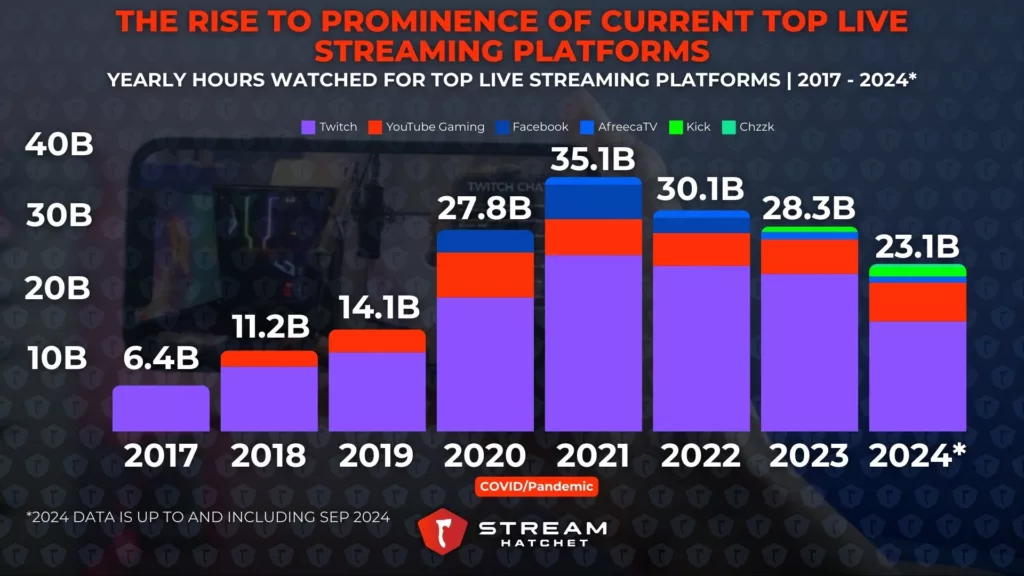
The most popular live-streaming platforms in 2024 are a combination of legacy platforms, platforms targeting specific markets, and disruptor platforms offering an alternative to disgruntled users of pre-existing competition.
The legacy platforms that contribute the vast majority of live-streaming viewership are Twitch and YouTube. Twitch is the Amazon-backed live-streaming platform that jump-started the industry back in 2011 when its creators realized the popularity of video game content. Many other live-streaming platforms use Twitch’s movements as their barometer for the industry as a whole, and so it behooves the critically-thinking analyst to fully understand all the basics of Twitch.
Google-backed YouTube branched out into live streaming after Twitch, but thanks to its pedigree in supporting independent creators, the platform soon found a loyal following. In particular, more kid-friendly streamers and streamers from Japan (particularly VTubers) tend to choose YouTube over Twitch due to its non-age-restricted accounts and dual live/non-live capability. When asked what is the best live-streaming service, most users would have to choose either Twitch or YouTube due to the sheer size of their communities and variety of offerings.
In saying that, some platforms have carved out a niche with alternative offerings. AfreecaTV, for example, is a legacy live-streaming platform from South Korea that rose to prominence alongside the local esports industry. When Twitch shut down its service in South Korea in early 2024, this solidified AfreecaTV’s presence in the area. As such, AfreecaTV is the go-to platform for South Korean streamers.
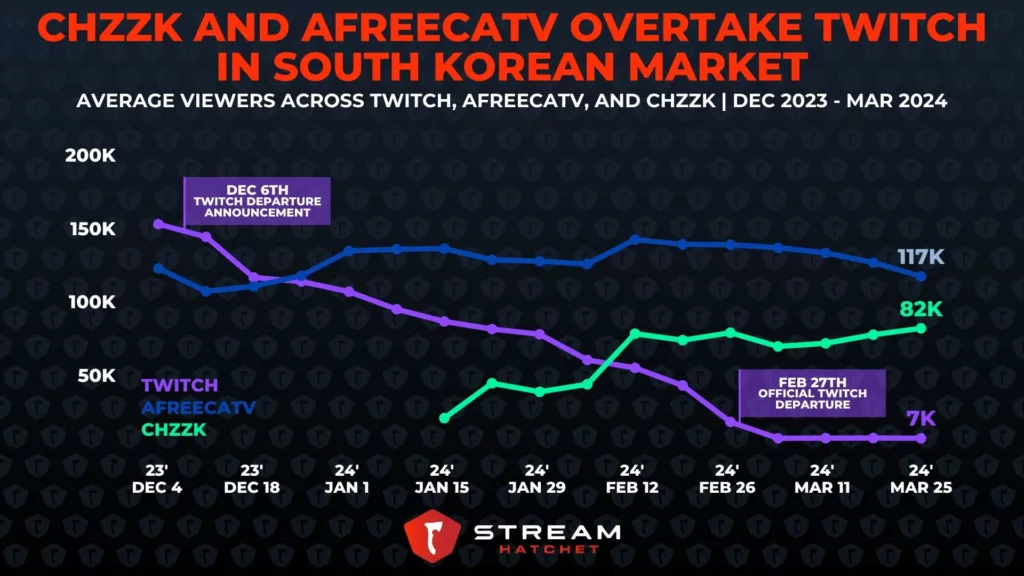
South Korea’s live-streaming industry is another fantastic example of shifting trends and disruptors, however. With Twitch shutting down, a new platform called Chzzk saw an opportunity to mimic Twitch’s UI and target South Korean audiences. Compared to the outdated aesthetic of AfreecaTV, Chzzk seemed fresh and modern. In response, AfreecaTV has rebranded to SOOP and updated its image. This small conflict shows how live-streaming platforms are in a constant battle to stay relevant as befits the trend-driven industry.
Another disruptor, Kick, launched back in 2022 with promises of servicing streamers who were fed up with Twitch’s monetization structure and community guidelines. Although it’s far too early to comment on whether it will be successful moving forward, Kick’s ability to attract top streamers in the industry has given them a fighting chance against the titan that is Twitch.
Again, this is just a small sampling of live-streaming platforms. More traditional social media apps have also implemented live-streaming options, like Instagram Live, Twitter/X and TikTok Live. And there are a wide array of platforms that have fallen out of favor with modern streaming audiences, from once-giant platforms like Facebook Live to platforms that collapsed under controversy like Periscope. For a full list of platforms that Stream Hatchet tracks, please reach out to one of our consultants:
The Most Popular Streamers in Live Streaming History
For as many live-streaming platforms as there are, there must be tens if not hundreds of thousands more streamers. It’s impossible for a beginner to know all of this many streamers’ names – especially when so many use abstract usernames like xQc and fps_shaka. Regardless, the top streamers will tend to sound familiar even to the uninitiated due to the sheer size of their influence.
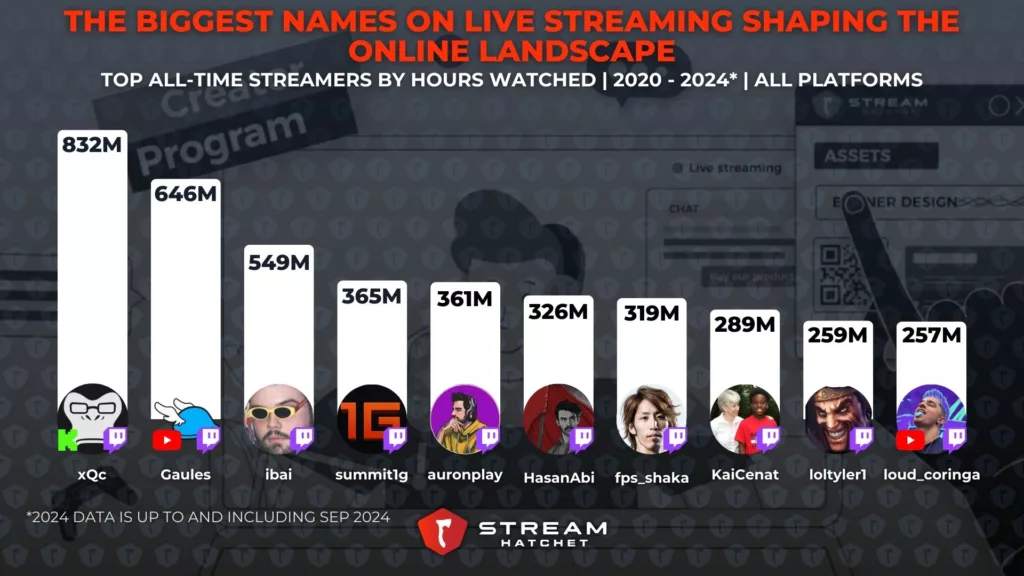
Looking at the top streamers over the past five years, it reinforces how crucial Twitch is to the live-streaming industry. Every single top streamer uses Twitch, with xQc’s move to Kick in 2022 being the only departure from this trend. Live-streaming platforms used to demand exclusivity from their streaming partners, but in the past couple of years, restrictions have loosened and allowed streamers like Gaules and loud_coringa to stream on both Twitch and YouTube.
Although these are the top streamers across the last five years, the top streamers in any given month are often radically different as creators find success with new games, emerging trends, and innovative content types. KaiCenat would be considered by many to be the most popular live streamer in 2024, impressively making the top 10 despite having only blown up earlier this year. To keep up to date with trendy streamers, it’s important to keep an eye on the current top streamer rankings for different platforms:
Live Streaming is the Modern Home of Video Game Content
The type of content being produced on live streaming is incredibly varied: Concerts, sports, Q&A’s, vlogs, webinars, product announcements… The list goes on and on. Live streaming’s versatility encourages an “if you can dream it, you can make it” mentality. But largely, there are two broad categories of content that make up most viewership on the big live-streaming platforms: Video games and IRL content.
Video games are the reason live streaming is thriving today. Twitch has been referred to as the “ESPN of video games” – the go-to platform for all esports, speedrunning, and casual gaming content. With the advent of live streaming, video games entered the mainstream and became something that was not just accepted, but highly profitable. Game publishers use live-streaming platforms to promote their upcoming games, and viewers turn to their favorite streamers for ideas on what game to play next.
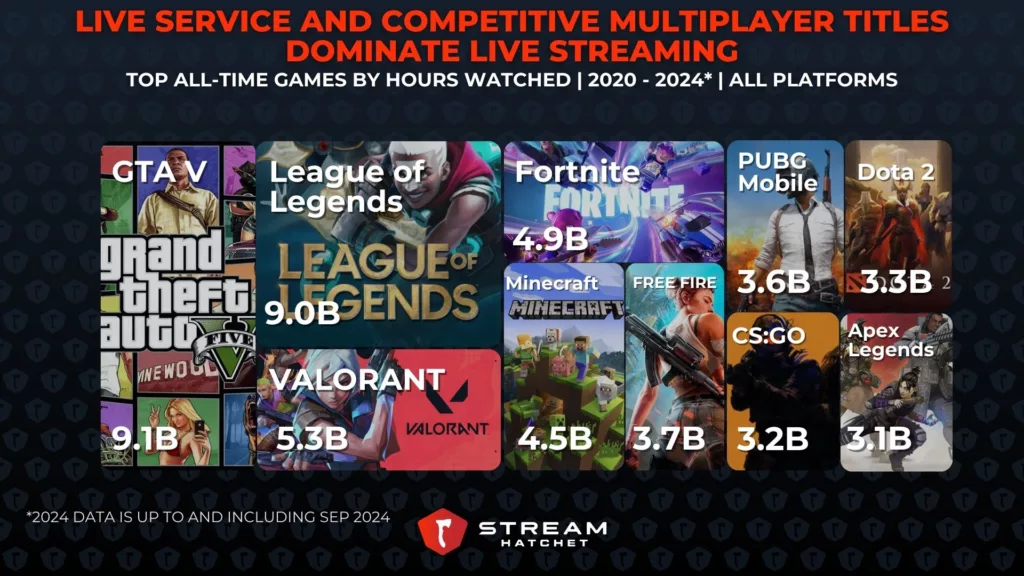
Looking across the top games on live streaming from the past five years, there’s a common theme: People love watching competitive, multiplayer titles. 8 of the top 10 games fit this theme, covering different genres from MOBAs (League of Legends, Dota 2), to Shooters (VALORANT, Counter-Strike: Global Offensive), to Battle Royales (Fortnite, Garena Free Fire). The only exceptions to this rule are GTA V and Minecraft – both of which are still multiplayer games, but encourage sandbox experimentation and role-playing. What’s clear is that social compatibility is key to live-streaming success for video games.
This prevalence of competitive titles also goes hand-in-hand with one of live streaming’s best known features: Esports coverage. Live streaming is the default method for broadcasting esports events, existing in a mutually beneficial relationship with live streaming: Live-streaming platforms give esports visibility, and esports give live-streaming platforms traffic. Esports has come a long way since its origins back in the days of Quake and StarCraft, with the recently concluded Esports World Cup featuring an Olympics-level spectacle and a vast array of games hosted in one spot.
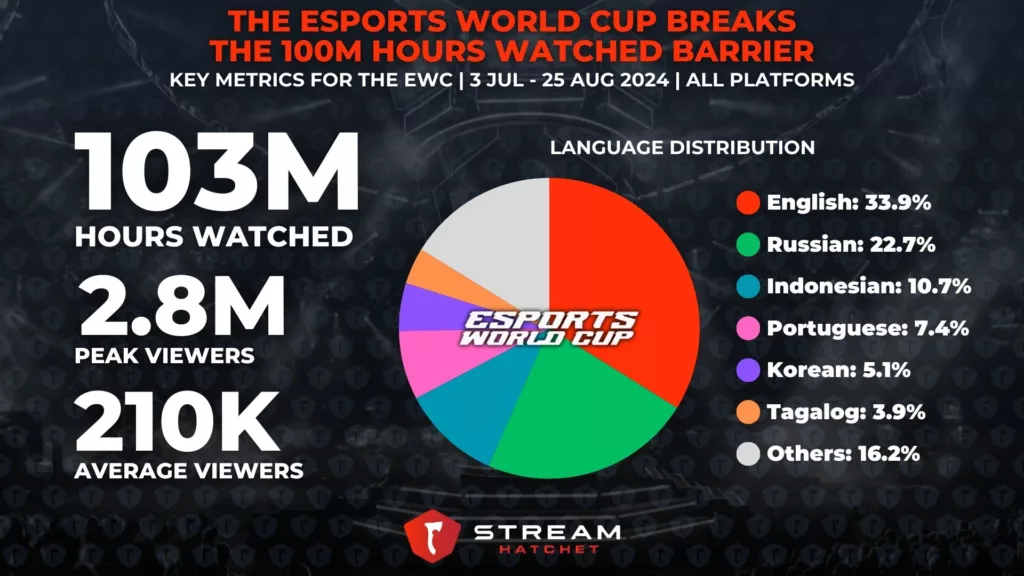
Esports is a beast unto itself: Attracting sponsors to your own streaming events or, if you’re a brand, finding the right event to sponsor may seem like an insurmountable task. If you’re planning on entering the world of esports, it’s worth at least having a chat with an expert before diving headlong into the industry:
Aside from video games, IRL content continues to gain momentum on live streaming. Current top streamers like IShowSpeed and streamer collectives like FaZe Clan have proven that bringing viewers into your life can create a deeply intimate connection. Stunts, collaborations, watch parties, holiday vlogs, and cosplay dress-ups are just a few of the many ways that creators can create live streams without exclusively depending on video game viewership – although many streamers will take a hybrid approach to their content.
Live Streaming as a Marketing Tool: The Modern Media Landscape

As popularity for live streaming boomed, advertisers caught wind of an entirely new way to promote their brands. Where live streaming on traditional media is restricted to only the biggest events in news, sports, and entertainment, live streaming online brings its advantages to smaller brands and companies with niche audiences. Live-streaming advertisements have been proven to have 30% better sales conversions than other routes, with China seeing $98B in e-commerce from live-streaming retailing.
Certain brands flourished with this new distribution channel. The generally younger audience on live-streaming platforms (primarily Gen Z) benefitted fashion and tech brands. Niche disruptors also found their following amidst the crowded marketplace thanks to live streaming’s ability to foster online communities. Of course, given the popularity of gaming on live streaming, game publishers and other entertainment providers are also using live streaming as a way to get their products in front of consumers. In particular, finding events to sponsor on live-streaming platforms was a massive boon for brands.
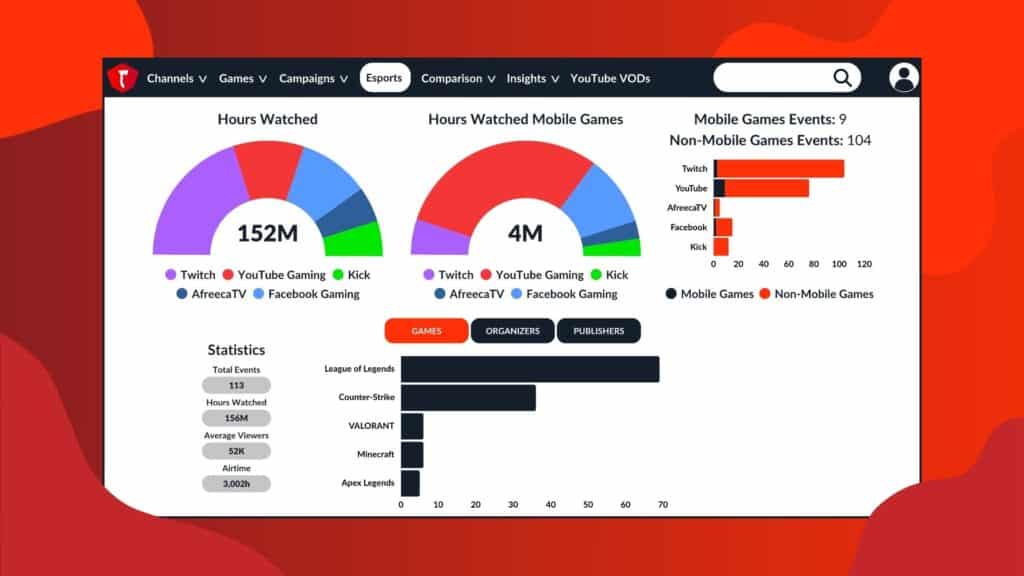
One of live streaming’s biggest advantages when it comes to marketing is how personal it feels: Viewers interact directly with the streamers promoting advertisers’ brands. Even compared to the many other routes for influencer marketing such as Instagram and TikTok, live-streaming platforms are primed for viewer engagement. Live chats, community events, and sponsored streams all put brands front and center without feeling as though they are imposing on viewers’ time. Given the deep level of trust that viewers develop with streamers over many hours, it makes taking their brand recommendations that much more natural – like a friend promoting a product through word-of-mouth.
If you’re interested in upgrading your influencer marketing strategy with your own customized Ambassador Program, reach out to Stream Hatchet today:
Regional Popularity for Live Streaming Content
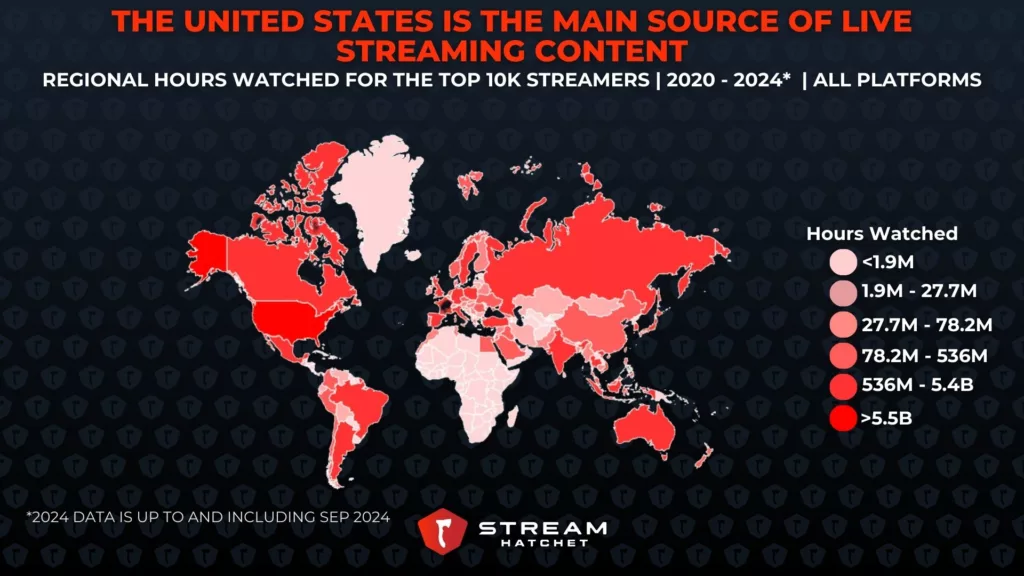
Although live streaming is a globally available service, there are a dozen or so countries that contain the bulk of the live-streaming demographic. By far the most popular is the United States, which pulls in more than triple the hours watched compared to the next most popular country, Japan. This analysis only considers the top 10K channels per year over the past five years, but that still broadly covers most live-streaming viewership.
Beyond the U.S. there tend to be touchstone countries for different languages. The top 10 countries each cover different languages (except Canada), showcasing how viewers from different parts of the world find their own popular streamers despite many of them covering the same big esports titles. Naturally, each region has its own specific trends as well, such as the dominance of VTubers in Japan or the popular “trash-streaming” subcategory in Russia.
Key Metrics Used in Live Streaming Analysis

As the industry ballooned and brands sought to market on live-streaming platforms, it became even more important to find a way to track the success of different games, streamers, and events. Key metrics for measuring live-streaming performance emerged out of this need to assess popularity, many of which require some explanation for outside readers. Just a few key metrics are defined here:
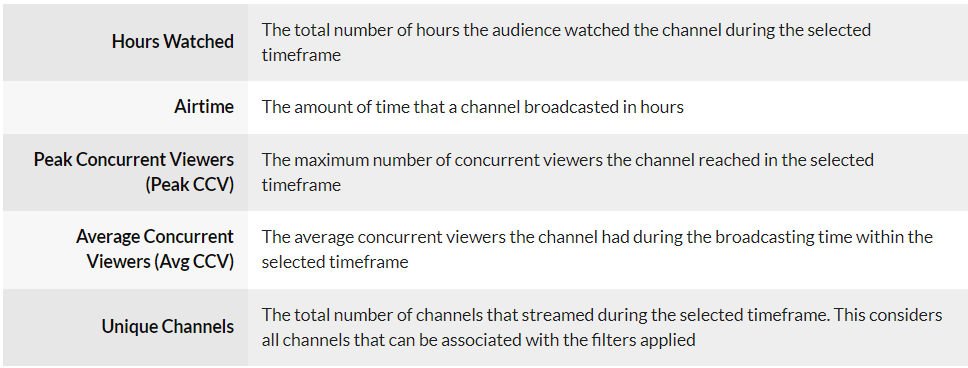
These key metrics evolved out of traditional TV broadcast metrics, like those used in the Nielsen rating system. But live streaming offers many other ways to measure success beyond simple viewership. Chat analysis allows analysts to gauge whether viewers are actively engaging with streamer content and what they are saying about said content. For brands, this kind of information is indispensable for gaining an insight into viewers’ minds and gauging the actual sentiment of their opinions. Overlap analysis uses unique registered viewers (URVs) to see whether fans of one game are also checking out a related game on live streaming. Game publishers can use this information to target streamers of pre-existing games for influencer marketing approaches to their upcoming game launches.
Those are just a couple of entry-level examples, but with a custom brief it’s possible for Stream Hatchet’s team of expert advisors to provide even more detailed metrics:
Heading into 2025, the live-streaming industry is one of the most advanced ways to engage with audiences; not just for video games, but for a range of brands from energy drinks to financial services. For advertisers and publishers looking to form an intimate bond, live streaming is a necessity. For content creators, live streaming is even more of a no-brainer. There is no avenue that more intimately connects a creator to their fans than live streaming: Getting to chat with the people who love what you do, and getting the satisfaction of crafting memorable moments with them is invaluable.
Live streaming continues to grow, change, and find new audiences. To keep up to date with every live streaming trend, follow Stream Hatchet:


